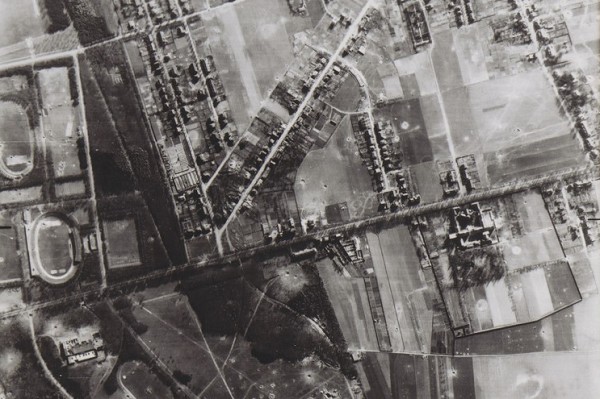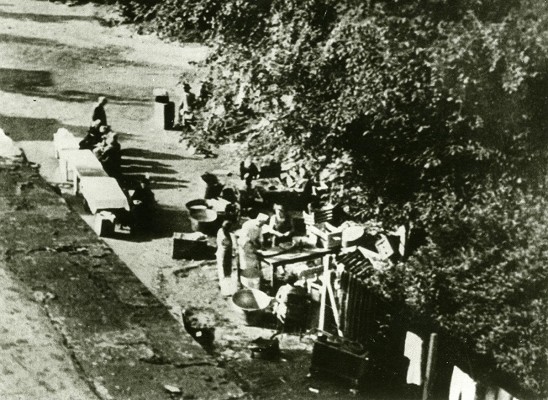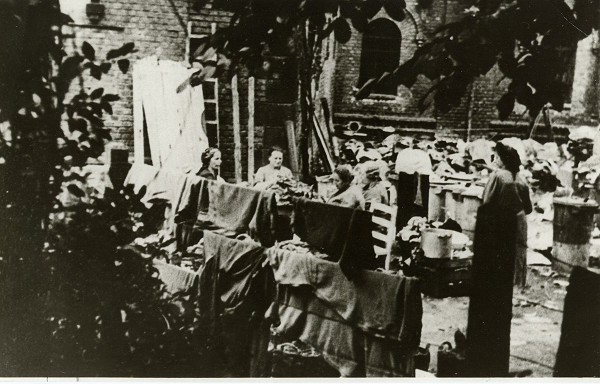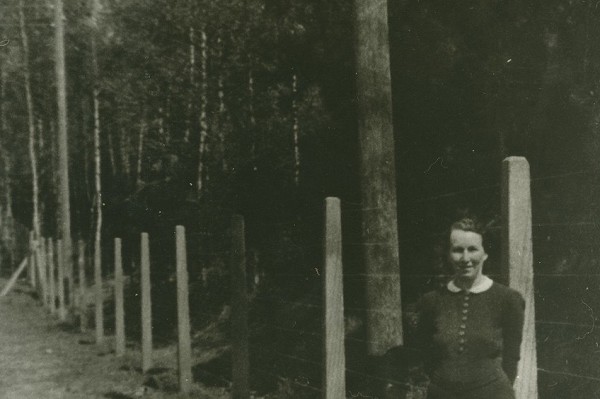Müngersdorf
deportation camp memorial site
A detention and deportation camp was located in Cologne-Müngersdorf from 1942 untill 1945. Thousands of people, mainly of Jewish origin, were deported from there to concentration and extermination camps. Here you will find background information that you can also access on site using a QR code.
Memorial site Deportationslager Köln-Müngersdorf 1941 – 1945
Approximately where the entrance to the allotment "Waldfriede" in Müngersdorf now is, there used to be the gates to the terminal stop on the way to hell. From 1941 till 1945 there was a hutment on this site. Together with the former Prussian fortress Fort V a few hundred metres away, it served the Nazis as a deportation camp. From here thousands of people of Jewish origin were deported to the extinction camps.
Owing to fortunate circumstances, the "Bürgerverein Müngersdorf" (citizens' organization in Müngersdorf) came across the architect and artist Simon Ungers whose estate is administered by Sophia Ungers, director of the archive "Ungers Archiv für Architekturwissenschaft". The inheritance contained a draft of a huge sculpture which in its symbolism and genesis perfectly matched the ideas of the project.
Barracks
The allotment is situated on the site of a former hutment which was used as a detention and deportation camp by the Nazi-regime from 1942 until 1945. Its structure and extent are still visible in the layout of the paths.
Of 36 wooden huts which were initially planned, at first only 12 were finished in a simple construction type without any heating. Since the beginning of 1942 hundreds of Jewish men, women and children from Cologne and the surrounding area had to move into the semi-finished camp without paved paths, sewerage, running water and sufficient sanitary facilities. All of them were deported to the ghettos and extinction camps until the end of 1943. Only a few of them survived.
In 1943/44 the hutment was used by the building firm Eichhorn Bauunternehmung as a “Gemeinschaftslager” (community camp) to accommodate labourers and forced labourers of various nationalities. Since September 1944 Cologne’s Gestapo interned Jewish men and women in “mixed marriages” as well as men, women and children who were considered as being “half-Jewish” on this site. Many of them were deported from here.
After the Gestapo’s detention camp on the premises of Cologne’s trade fair were destroyed in an air-raid in October 1944, the Gestapo transferred the inmates, among them “Half-Jews”, forced labourers from abroad and other persons under arrest, to the camp at the Fort. In the light of the advance of the allied forces in the west, the detainees were successively transferred to prisons and other detention facilities. The last evacuation march bound for a Gestapo camp in Hunswinkel in the Sauerland region left Müngersdorf on March 1st, 1945.
Five days later, the US-American Forces arrived in Cologne.
Fort
You are currently standing on the grounds of a former Prussian barracks, Fort V, which was built in 1874 and abandoned in 1918. It originally consisted of spacious brick buildings with cellars and a number of wooden huts. In autumn 1941, the NS-authorities decided to use the derelict rearward part of the old barracks to intern the Jewish population from Cologne and the surrounding area. Shortly afterwards, Jewish men were forced to move into the Fort for a start to build further huts on the premises.
Hundreds of Jewish women, men and children were interned in the mouldy dwellings and casemates during the following months. All in all approximately 3.500 persons had to suffer in the fort and the hutment before their deportation. Internees were only allowed to leave the campsite with permission. Many had to work as forced labourers in companies and factories in Cologne.
The fort’s dwellings were depressingly overcrowded, the hygienic and sanitary facilities circumstances entirely in-sufficient. In this desperate situation, the internees tried to provide religious, mental and medical support for each other. Between June 1942 and late summer 1943 most of the men, women and children being interned here were deported to Theresienstadt ghetto and from there to the NS-extinction camps Belzec, Sobibor and Treblinka. Only a few of them survived. Other detainees were deported to the extinction site Trostenez near Minsk and to the Auschwitz concentration and extinction camp via Berlin in January 1943.
The ensemble erected on this memorial site is characterized by a work of art based on the draft of the architect and artist Simon Ungers (1957-2006) from Cologne.
Intersection
Between 1941 and 1945 the “Sammellager Müngersdorf” (internment camp) was situated in the area of present-day’s Walter-Binder-Weg. It was built at the instigation of the Gestapo in cooperation with the local authorities since autumn 1941 and was run by Cologne’s Gestapo. The camp consisted of the premises of the former Prussian barracks Fort V, of which only remains of the groundwork still exist, as well as a hutment, whose site nowadays accommodates an allotment.
The “deportation camp” marks the terminus of the inner-city ghettoization of Cologne’s Jewish population, its purpose being the internment of Jewish citizens from Cologne and the surrounding area. From here internees were deported to the ghettos and extinction camps in East Europe occupied by Germany. The hutment was used to accommodate forced labourers from abroad since 1943. In 1944/45 it was once again used as a detention facility by the Gestapo, this time for Jewish as well as non-Jewish groups of people.
Upon decision by Cologne’s city council a bowlder with a plaque was put up on the roadside to commemorate the deportation camp. Due to the initiative of the Bürgerverein Müngersdorf a fundamental redevelopment of the historic site took place. The areas of the former camp are now traceable, information on the function and significance of the camp is provided and a work of art based on the draft of the artist Simon Ungers serves as a place of remembrance. The stones used for the pavement pick up the bricked buildings of the former barracks.
The history of the deportation camp in Cologne-Müngersdorf
Between 1941 and 1945 roundabout 3.500 Jewish people from Cologne and the surrounding area were interned in the Müngersdorf deportation camp. It therefore played a crucial role in the NS-regime’s persecution- and extinction-system and was the starting point of the Shoah in Cologne.
In the summer of 1941 Cologne’s local authorities started discussing the possibility to establish an internment camp for the remaining Jewish citizens still living in the city. A few months earlier, in May 1941 the spatial segregation of Cologne’s Jewish population had reached a temporary peak, when off-limits areas were declared and the remaining Jewish inhabitants had to move into roundabout 270 designated “ghetto houses” situated in the boroughs of Altstadt, Neustadt, Ehrenfeld and Nippes.
Apart from Cologne’s Gestapo office and the local “Gauleiter” Joseph Grohé who were the driving forces behind the measures, municipal offices such as the building authority and the city treasury were involved from the beginning as well. By segregating the Jewish community from Cologne and the surrounding area in a remote camp outside the city center, the authorities sought to enhance their spatial concentration and isolation from the non-Jewish population.
At first, ideas about the layout of such a camp were vague and several potential sites were considered, but soon the premises of a former Prussian barracks in the outer green belt in suburban Müngersdorf were chosen. The previous purposes of the site still showed in the camp’s name “Fort V”, as it was commonly known.[i] The fort had been built in 1874 as part of the Prussian city-fortification and had served as a military prison between 1879 and 1918. It was abandoned in 1918 and had subsequently fallen into ruins by the mid-1920s when large parts of the disused buildings were demolished in the course of a redevelopment scheme to turn the site into a woodland- and recreation-area. Only the rearward part of the Prussian barracks remained.
Since the old barracks did not provide enough space to accommodate the better part of the 5.500 Jews still living in Cologne the site was extended by a hutment on an adjacent field to the north of the former Prussian fort.
After more than 20 years of vacancy, the remaining barracks were in a derelict state and thus entirely unfit for housing people as a report written on behalf of the Reichsvereinigung der Juden in Deutschland / Bezirksstelle Rheinland (henceforth RVJ) as the official representative organization of the Jewish community in autumn 1941 depicts. Not only did the paint come off the damp walls, caused by the moist and draughty conditions in the rooms, but many were also mould-infested. There was no proper pavement throughout the camp nor was it connected to the public sewers, making open pits the only facilities to dispose of the wastewater.
The left wing of the double-winged building consisted of 16 rooms alongside a 110 metres long corridor with an average size of 35 square metres and only one small barred window of 1 x 1,80 metres. The cellar vaults were entirely windowless.
Four rooms at the end of the corridor were used as toilets providing eight seats each for men and women together. Other sanitary facilities such as baths, washing basins and showers had yet to be installed. One of the other rooms was supposed to serve as a communal kitchen.
While the barracks still had a grid connection, neither the old fort nor the newly erected hutment were connected to the water network.
The conditions in the newly built hutment northwest of the barracks were similarly inadequate. 36 wooden huts, a sanitary barrack and two latrines were to be erected in a simple construction type on an open field. The huts of different sizes were built from wooden boards on a concrete foundation with single boards being used for floors and roofs and double-boards with a thin cardboard insulation for the walls.
The RVJ criticized these circumstances and finally succeeded with some of their demands to improve the conditions before the Jewish inhabitants had to move in. During the last three months of 1941 the future campsite underwent reconstruction which was mainly carried out by Jewish forced labourers from Cologne.
The regional office (“Bezirksstelle Rheinland”) of the RVJ was forced to take part in the planning and execution from the beginning. It was actively involved in the organization of the construction work, including the acquisition of essential tools such as ovens and cookers donated by members of the Jewish community as well as making financial contributions. Although the government officially paid for the construction of the internment camp, the RVJ had to spend 800.000 “Reichsmark” in advance, of which only about half of the amount was later re-compensated.
Most of the correspondence between RVJ’s regional office in Cologne and its headquarters in Berlin as well as correspondence with the Gestapo and the local authorities has survived and is now held by the National Archives (Bundesarchiv) in Berlin. The letters and minutes depict to what extent the RVJ was compulsorily involved in the planning and construction of the campsite thus playing an important role in the segregation and persecution of their fellow Jewish citizens during this last phase before the deportations.
But the sources also show that the RVJ’s representatives used every opportunity to grant relief for its members. Not only did they repeatedly demand a major refurbishment of the barracks. They also called for a smaller number of internees on various occasions, stating that with the intended number of several thousand people having to live in the camp there would hardly be enough space for everyone to put a bed and a wardrobe.
The first Jews from Cologne were transferred to the camp in 1942. Although they were only informed a couple of days prior to their removal which left them little time to gather the few personal belongings they were allowed to take with them before leaving their homes for good, the news did not entirely come as a shock for most of them. Rumors about the establishment of an internment camp had spread since autumn when the Gauleiter Joseph Grohé had given a programmatic speech at a mass assembly in Cologne’s trade fair.
Since October 1941 about 3.000 Jewish people had been deported from Cologne on the first three transports to the Riga and Litzmannstadt ghettos.
Since the end of 1941 the majority of the 2.500 remaining Jewish citizens from Cologne and around 300 residents from surrounding towns such as Bonn had to move to the camp and all but a few of the “Jew’s houses” in the city center were closed.
Despite the refurbishment that had been undertaken before the camp was opened, the infrastructure was still insufficient. The work on the newly-built part of the campsite had not been completed, leaving 12 makeshift barracks - of 36 initially planned - and another 10 still under construction in a muddy field without any heating, canalization or sufficient sanitary facilities. The rooms in the old barracks were still poorly insulated and also lacked proper sanitary facilities. The harsh winter of 1941/42 made the situation even worse.
The dwellings in the camp were soon overcrowded, leaving just a small space of a few square meters for each resident which granted them little privacy and provided no possibility to store the few personal belongings they had managed to rescue from their homes. Even formerly private activities such as personal hygiene, cooking and eating now had to be done in communal spaces.
In the old fort an average of 15 people stayed in rooms of 35 square metres while in the wooden huts up to eight people shared a compartment of 6 x 6 metres in size. The residents could either be made up of one or two families or several couples and single persons who had been randomly assembled. Most of the wooden huts consisted of four such compartments leaving up 30 residents to share one hut.
Even though the internees were used to the ongoing restrictions and exclusion of the past years, the situation in the camp represented an entirely new dimension of being dehumanized and deprived of their rights.
The situation got worse when the patients from the Jewish hospital (“Israelitisches Asyl”) and the “Jew’s houses for elderly people” which had so far remained in the city center, were also moved to the campsite following an air-raid on Cologne on 31st May 1942. Although the buildings had survived the air-raid intact, they were seized the next day to provide the new accommodation for the nearby Bürgerhospital whose buildings had been entirely destroyed.
More than 400 residents of the home for elderly people and an unknown number of in-patients and staff came to Müngersdorf on June 1st, 1942.
With too little space to accommodate the new residents, people had to take lodgings in the underground arches or even in the courtyards outside. Sometimes patients and nurses had to share a bed, in other cases ill people took lodgings with relatives, who already lived in the camp. As one of the nurses later testified in her eye-witness account, the living conditions were horrific. These along with the influx of sick and elderly people significantly increased the death rate in the camp in the following month. Also several suicides are known.
Descriptions of the circumstances in letters which several internees wrote to friends and relatives as well as eye-witness accounts of survivors give insights into the inhumane living-conditions.
According to these eye-witness accounts the internees seem to have developed a sense of community and tried to maintain a social life as far as possible, despite the lack of privacy and the high fluctuation. A lot of them knew each other and many of those who came from the same “Jew’s house” still lived close to each other in the barracks. Thus residents frequently visited and supported each other, often developing strong bonds which lasted beyond their deportations.
The employees of the RVJ were mainly responsible for the camp’s administration under the auspices of the Gestapo. Their administrative tasks included informing the Jewish residents about the upcoming move to the internment camp and organizing their removals. Besides hey also had to provide groceries and other necessary goods for everyone in the camp as well as administering the monthly rent of 36 Reichsmark which the internees had to pay.
Though they were far from being autonomous the will to offer small relieves for the inhabitants whenever possible can be seen in their activities. Apart from regular counselling, the head of the office and the community’s last remaining rabbi organized services, lectures and singing classes for young people.
80 % of the internees had to work as forced labourers within the camp or in various factories and private businesses. For many of those being employed outside of the camp going back and forth to their workplaces involved long marches on a nearly daily basis.
The campsite was fenced and Gestapo-officers and SS regularly patrolled the premises. Nevertheless, the inhabitants were never completely cut off from the rest of the society. The camp was close to the residential area of the small town Müngersdorf, the spire of the parish church still being clearly visible from the campsite today. But despite the proximity most local residents took little interest in the camp and its internees and there was hardly any contact between the Jewish residents and the general public. Only very few examples of locals who offered help and support to the people living in the camp are known, among them a local GP who visited the camp several times between May 1942 and June 1943 and offered to help with obtaining medicines.
Although during the first months internees were still able to obtain travel permits which occasionally allowed them to visit friends and family living elsewhere with the growing restrictions to use public transport it became increasingly difficult and strenuous. Thus most of the internees soon had a strong feeling of utter isolation and segregation.
Despite a formal ban of visitors from outside the camp, the internees were occasionally able to welcome visiting relatives or friends. Although the case of a GP’s family, whose former non-Jewish housemaid visited them several times may be a rare one, it shows there was never a complete physical isolation.
The time the residents spent in the camp varied greatly ranging from a couple of days to six months and more. By the end of 1943 all residents of the camp including the last representatives of the RVJ had been deported to ghettos and extinction camps such as Minsk, Theresienstadt and Auschwitz. For most the camp was the last place of residence before the deportation, it must thus be seen as a preparative for the deportations and mass extinctions of the Jewish population.
After the last internees had left the camp in autumn 1943 the camp’s premises were temporarily used by the building firm Eichhorn Bauunternehmungen to accommodate forced labourers of various nationalities, before being turned into an internment camp for Jews once again in September 1942.
On September 12th, 1944 a Gestapo-order summoned everyone living in a “mixed-marriage” (“Mischehe”) or being “half-Jewish” from Cologne and the surrounding area to the camp. After a fortnight the non-Jewish partners and their children were forced to leave the city within two days while the Jewish partners remained in the camp. Many of them were subsequently deported to Theresienstadt Ghetto or to work-camps run by the “Organisation Todt” in Hessen and Thuringia. Other remained in the camp until the beginning of March 1945.
Some managed to escape from the camp in the confusing situation during the first days of the internment.
After the Gestapo’s detention camp on the premises of Cologne’s trade fair were destroyed in an air-raid on October 14th, 1944, the Gestapo transferred the inmates, among them “Half-Jews”, forced labourers from abroad and other persons under arrest, to the camp at the fort.
In the light of the advance of the allied forces in the west, the last evacuation march bound for a Gestapo camp in Hunswinkel in the Sauerland region left Müngersdorf on March 1st, 1945. Dozens died on the way from illnesses and starvation.
Five days later, the US-American Forces arrived in Cologne.
This speech was made by Gauleiter Josef Grohé on September 28th 1941 at a large rally at the Cologne Trade Fair, to mark the opening of the assembly camp for Jews in Cologne-Müngersdorf.
Grohé:
“Adolf Hitler said – and this was in a speech before the start of the war – “If international Jewry should again succeed in plunging the peoples of the world into war, then the end of this war will be the complete expulsion of the Jews from Europe.”
Applause
And now they have actually succeeded in unleashing this war. For the moment they are still free to move about, but remittance is no quittance!
Applause
In Cologne alone, let’s face it, we have some 6000 Jews taking the food out of our mouths, and for the most part doing nothing but making a nuisance of themselves.
They now have to wear the Star of David. You have seen the Star of David, and many of you have come forward in horror and said, “For God’s sake, I have never seen so many Jews as this in Cologne before, where did they all come from?”
Well, there is an explanation for this.
First of all, you don’t always look a Jew in the face, for there is a saying, as you know, to the effect that God gave the Jews a distinctive physical feature in their noses – this is the uniform of the Jews, given them by God. No, you don’t always look them in the face, and there are also Jews with snub noses – it does happen.
With the East Galicians, for instance, the nose is generally different, and then too, you hear of the smell – well, when you walk through the streets of the city, you don’t always have the wind against you.
Laughter
So it was high time they should be made to wear the Star, and now we can see what vast numbers of them are still at large.
In Cologne we are removing them from the houses assigned to them, and the reason for this is that we want to be able to give our German compatriots, who have had their homes destroyed by bombs, secure housing to move into.
Applause
So the question here is, “Who has priority?”
Our German compatriots, whose homes have been smashed up by the English as a result of the war plotted by the Jews – or the Jew, our domestic enemy?
The question hardly needs an answer.
We could simply expel the Jews from their houses and leave them to their fate – say to them, “Get out of our way!”
Consider for a moment what is going on. They are being moved, some of them into one of the old Cologne forts, and for the remainder barracks are being built, completely new barracks, the sort of barracks that have to be put up for our soldiers and for the Labour Service, barracks that are needed for our foreign workers, for prisoners of war and many others.
So yet again we are dealing so generously with the Jews that we really have to express amazement at our own German good nature, as confirmed by our actions.
Only the good-natured Germans can behave in such a way.
Well, I think that the Jews have laughed for long enough – their laughter will soon die away, we will be rid of them shortly and until we are, we will not feel that we are clean ourselves!
When I talk about the Jews, I always have the feeling that I need to wash my hands.
It really is the case that there is nothing more miserable and despicable in the world than the Jewish people, and there is nothing in the world more good-natured than the Germans, who here again are wondering whether things aren’t perhaps a bit too harsh.
But this is not the way we deal with vermin. And vermin, and nothing else, is what the Jews are.
Vermin among the German people, and among the other peoples of the world.
But this war, in which Germany will be victorious, will bring the victory of the swastika throughout Europe, and the result will be the downfall of the Jews.”





